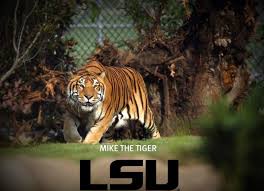
The LSU campus buzzed on October 21, 1936, as the student body awaited the arrival of “Sheik,” a live tiger from the Little Rock, Ark., zoo that would serve as the university’s first official mascot. A campaign to bring a live tiger to Baton Rouge had been initiated in 1935 by Mike Chambers, the school’s head athletic trainer.
“He put up signs around campus and urged students to contribute money for this endeavor,” said Bud Johnson, a former LSU sports information director and now the director of the Andonie Sports Museum adjacent to the LSU Alumni Center. “The campus was a much smaller place then, and virtually everybody knew who was behind the campaign.”
Chambers, who arrived at LSU in 1934, was already a widely respected figure on campus who was known to run onto the field and hoist injured football players over his broad shoulders to bring them to the sidelines for medical attention. He was also regarded as a valued mentor to the student-athletes, stressing to them the importance of an education to complement their playing careers.
Sheik arrived on campus to much fanfare, but there was a strong sentiment among the students that he should be re-named to better represent the university. When the students, who had contributed a total of $750 to bring the tiger to Baton Rouge, were asked their opinion on a new name, they unanimously shouted “Mike” in honor of Mike Chambers.
The storied tradition of “Mike the Tiger” at LSU was born.
Even before coming to LSU at the age of 36, Mike Chambers had lived a remarkable life. He was born in New Orleans in 1898, raised in Cairo, Ill., and after graduating from Cairo High, he served in the Navy during World War I, becoming a champion boxer in the light-heavyweight division. After his enlistment expired in 1920, he played football at Southeast Missouri State, and then at Illinois, where he blocked for the legendary Red Grange.
He worked as the manager of the Cairo Natatorium in 1922-23, when he trained diver Caroline Smith, who went on to win the gold medal on the 10-meter platform at the 1924 Olympics in Paris.
Chambers worked as the head trainer at Iowa State and at Ohio State, and in 1928, he was named head trainer of the United States Olympic track and field team. He worked in 1929 as the trainer for baseball’s Pittsburgh Pirates, and he served from 1929-34 as head trainer, boxing coach and assistant baseball coach at Georgia Tech before taking the job at LSU.
“To say that the man was driven would be a huge understatement,” said Jeff Lien, Chambers’ grandson. “He certainly loved sports, but he also loved people, especially students. He was the man in the center of the room, the storyteller, the motivator, the first to jump into the fight, and he would stay awake for days to prepare an injured player for an important game.”
Lien said his grandfather was a larger-than-life figure on the LSU campus, called “Mr. Mike” by the students. He was a lover of literature, and he enjoyed singing and listening to music. He also met his future wife, Margery Dyson, at LSU. She was a dietitian and worked closely with Chambers in planning meals for the student-athletes. They fell in love and were married on November 30, 1937. Mike and Margery had one daughter, Mary Olive, the mother of Jeff Lien.
Chambers graduated from LSU in August 1938 with a degree in health and physical education, and he left Baton Rouge in 1939 to become the head trainer at UCLA, where he trained future Baseball Hall of Famer Jackie Robinson.
Chambers re-enlisted in the Navy in 1941 – several months prior to Pearl Harbor – serving as Regimental Commander at the Recruit Training Command in San Diego. He requested on several occasions to be deployed overseas with the troops he trained, and in 1944, he became an active Naval Commander in the Pacific. He fought in the Battle of Kwajalein, the Battle of Eniwetok Atoll, and the Battle of Saipan in the Pacific, and he remained on active duty until the end of World War II.
After the war, Chambers entered private business in San Diego, and his last sports-related job came in 1953, when he worked as trainer for the Sacramento Solons, a baseball team in the Pacific Coast League. He was inducted in 1962 into the National Athletic Trainers Association Hall of Fame.
Chambers made his final visit to the LSU campus in October 1968, when he and his family were honored in Tiger Stadium at the Homecoming game versus TCU. Chambers proudly rode alongside Mike III as they circled the field to thunderous applause.
Chambers remained a dedicated reader of classic literature, and he continued a weight-training regimen into his ‘70s. He communicated often with his former LSU student-athletes, coaches and trainers, and his love for the university never wavered.
Michael Chellis Chambers passed away on December 31, 1975, in San Diego.
A tough and fearless man, he had served in two World Wars, played college football at the highest level and trained Olympic athletes, but Mike Chambers especially cherished the impact he made upon the LSU community.
“The highlight of his career, he always felt,” Johnson said, “was having the LSU Tiger mascot named after him.”
“We feel very honored for this recognition, and are excited to join the LSU community in permanently adding his name to the Athletic Hall of Fame,” Lien said. “We are proud of him and all that he was able to accomplish in his lifetime, and we hope that LSU will always remember the namesake of ‘Mike the Tiger,’ Mike Chambers.”